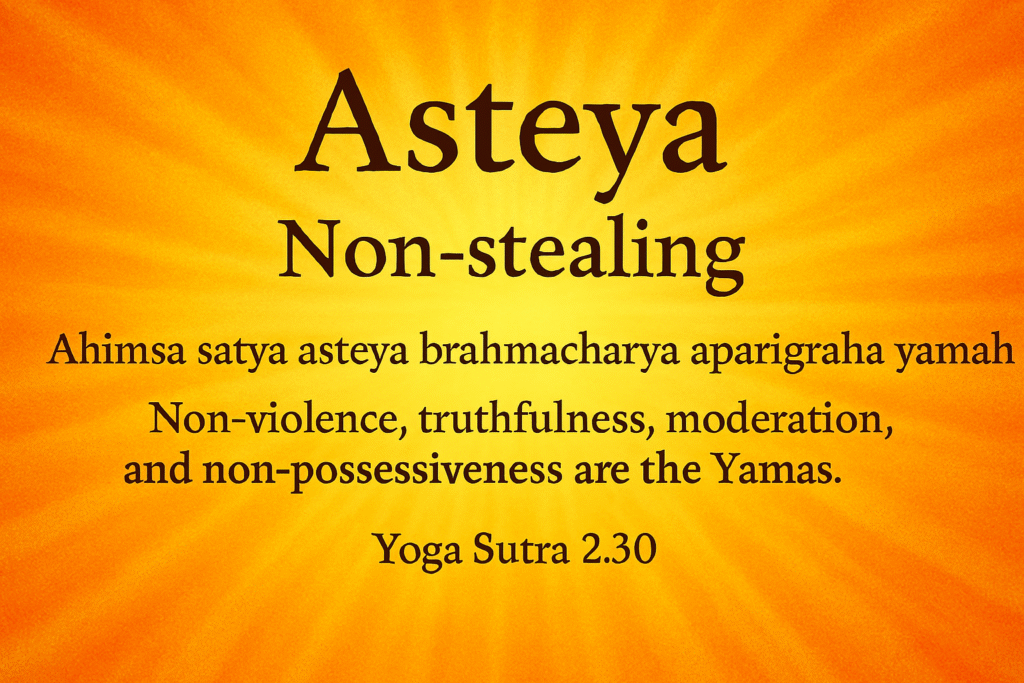Asteya | Cultivating Integrity Through Non-Stealing
In the ethical framework of yoga, Asteya—non-stealing—is a principle that reaches far beyond the literal act of theft. Rooted in Patanjali’s Yoga Sutras and embedded in the Eight Limbs of Yoga, Asteya invites us to examine how we take, consume, and occupy space—physically, emotionally, and energetically. It is a call to live with integrity, generosity, and trust.
Asteya in Patanjali’s Yoga Sutras
Asteya is the third of the five Yamas, the foundational ethical restraints outlined in Yoga Sutra 2.30:
Ahimsa satya asteya brahmacharya aparigraha yamah
Non-violence, truthfulness, non-stealing, moderation, and non-possessiveness are the Yamas.
Patanjali expands on Asteya in Sutra 2.37:
Asteya pratisthayam sarva ratna upasthanam
“When non-stealing is established, all jewels present themselves.”
This poetic sutra suggests that when we stop grasping for what is not ours, we begin to recognize the abundance already within and around us. The “jewels” may be material, but more often they are qualities like contentment, clarity, and trust.
Asteya Within the Eight Limbs of Yoga
Though Asteya is introduced as a Yama, its influence permeates every limb of the yogic path:
- Niyama (Personal Observances): Asteya supports Santosha (contentment) by helping us release the desire to take more than we need.
- Asana (Physical Postures): Practicing Asteya means respecting our body’s limits and not “stealing” poses that aren’t yet ours through force or ego.
- Pranayama (Breath Control): Breath becomes a practice of balance—taking in only what we need, releasing without grasp.
- Pratyahara (Withdrawal of Senses): Asteya invites us to notice how sensory cravings can lead to subtle forms of stealing—attention, energy, or peace.
- Dharana, Dhyana, Samadhi (Concentration, Meditation, Absorption): These meditative limbs ask us to be present without clinging to insights or experiences. We learn to receive without grasping.
Asteya in Daily Practice
Asteya shows up in nuanced ways. It’s not just about material theft—it’s about energetic boundaries, time, attention, and trust. Here are some examples of how Asteya might manifest:
- Interrupting someone before they finish speaking—stealing their voice.
- Overcommitting and underdelivering—stealing others’ time or trust.
- Comparing yourself to others and coveting their progress—stealing your own peace.
- Teaching beyond your scope—stealing credibility from the lineage or tradition.
In the studio, Asteya means honoring each student’s journey. It means not rushing someone into a pose or a level of practice they haven’t yet earned. It means creating space where no one feels pressured to perform or compete.
Asteya as Abundance
Asteya is ultimately a practice of abundance. When we stop grasping, we start receiving. When we stop taking, we start trusting. When we stop comparing, we start celebrating.
Yoga teaches us that everything we need is already within us. Asteya reminds us to live from that place—not from scarcity, but from sufficiency.
In a culture that often equates worth with accumulation, Asteya is a radical act. It asks: What am I taking that isn’t mine? What am I withholding that could be shared? What would it feel like to live generously?
And in that inquiry, yoga deepens.
Continue your growth with the Vallarta Breeze Yoga Puerto Vallarta Yoga Studio!
Whether you’re looking to dive deeper into the physical practice of yoga, The Vedas, Upanishads, Yoga Sutras, or would like to explore our blog, we have a wealth of information available for you! Better yet, join us here in the Vallarta Breeze Yoga Puerto Vallarta Yoga studio, or practice with us online! we’re excited to continue this journey with you. See you on the mat!



